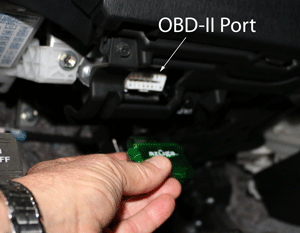
How does OReGO know how much fuel my car uses?
September 4, 2015 | OReGO Communications Team
That’s a great question! Here is a somewhat technical explanation of how your car reports fuel used. It’s through something called the OBD-II port – where you put the OReGO mileage recording device.
An on-board diagnostics port, known as OBD-II, is required on all automobiles and light trucks in the United States from 1996 onward. OBD-II is a set of specifications for monitoring and reporting engine performance in vehicles. Diesel (compression ignition) vehicles were not required to support OBD until 2004.
Prior to OBD, auto manufacturers did not standardize diagnostic trouble codes, known as DTC’s. OBD-I began the standardization of DTC’s and OBD-II added specific tests to determine the vehicles emission performance. OBD-III adds more features, and is in the regulatory development phase now.
The Society of Automotive Engineers (SAE) works with the automotive industry and regulatory bodies to develop standards for on-board diagnostics.
The OBD-II can capture data about fuel usage and mileage travelled via the mileage reporting device (MRD) that is used in the road usage charge program. The MRD transmits that information to your account manager to calculate your total road usage charge, minus fuel tax credits.
The MRD can measure fuel consumption by obtaining data from the engine. Some of this information comes from internal sensors that include the Mass Air Flow (MAF) sensor. The MAF sensor delivers a precise measure of the flow rate of air. This, combined with the air/fuel ratio, provides a precise measurement in determining the fuel consumption for trips. The MRD calculates miles traveled by measuring the amount of time your vehicle’s engine is on, over the speed of your vehicle. If you choose a commercial account manager, such as Verizon or Azuga, the mileage-reporting device operates as a scan tool to provide you with even more services. This may include giving you trouble codes and working as a trip computer.
So that’s why you don’t need to turn in receipts with OReGO – the vehicle reports how much fuel you’ve used! Pretty smart, huh?
6 thoughts on “How does OReGO know how much fuel my car uses?”
Leave a Reply
Recent Posts
July 20, 2018
OReGO is three years old this month and we are pinching ourselves thinking how far we’ve come since our launch […]
April 9, 2018
Do you remember the roads you drove last week? The bridges you crossed? The number of trips you took on […]
January 25, 2018
If you followed the 2017 legislative session, you know that Oregon lawmakers passed a new transportation funding package called “Keep […]

Robert says:
It would be convenient if manufacturer’s relocated the OBD-II port higher on the dash so it could collect position data as well. Not sure if this would be necessary for this purpose, but it aid in determining where to spend money collected.
tomfuller says:
I know what you mean, Robert. I had a somewhat hard time getting the device in my port and the Prius is supposed to be easy! Sadly, we can’t control where the manufacturers put these ports – as they were designed for mechanics to access.
I guess the good news is that, eventually, most cars will be fitted with something called “telematics” which means they already have cellular connection capability so the car can report to the OReGO vendor without needing a separate device – not that that helps us now!
Tom
Jack Cooperman says:
How specifically does the MRD transmit the information? What type of antenna does it have? What wavelength, format, or system is it using to communicate the requisite mileage and fuel consumption information to the account manager?
Jenny Erickson says:
Thanks for your question, Jack.
The MRD uses cellular, wireless, and radio communication technologies to transmit the data. As far as wavelength/format/system, each account manager would need to respond individually about their specific devices.
Contact information for each account manager is available via the vendor options page: http://www.myorego.org/about/vendor-options/. Simply click on the green “Learn more about this option” button at the bottom of each vendor column to access email, telephone, and other vendor-specific information.
david arkules says:
Could you please properly respond to the question posted by Jack Cooperman April 11th? Please do not point to a private vendors.
tomfuller says:
We do not control the technology but vendors must meet certain criteria such as security and reliability. The OReGO program provides options and a unique public/private partnership – that’s why it is the companies, not ODOT that has the information sought.